engine TOYOTA PRIUS 2010 3.G Owners Manual
[x] Cancel search | Manufacturer: TOYOTA, Model Year: 2010, Model line: PRIUS, Model: TOYOTA PRIUS 2010 3.GPages: 616, PDF Size: 10.45 MB
Page 5 of 616
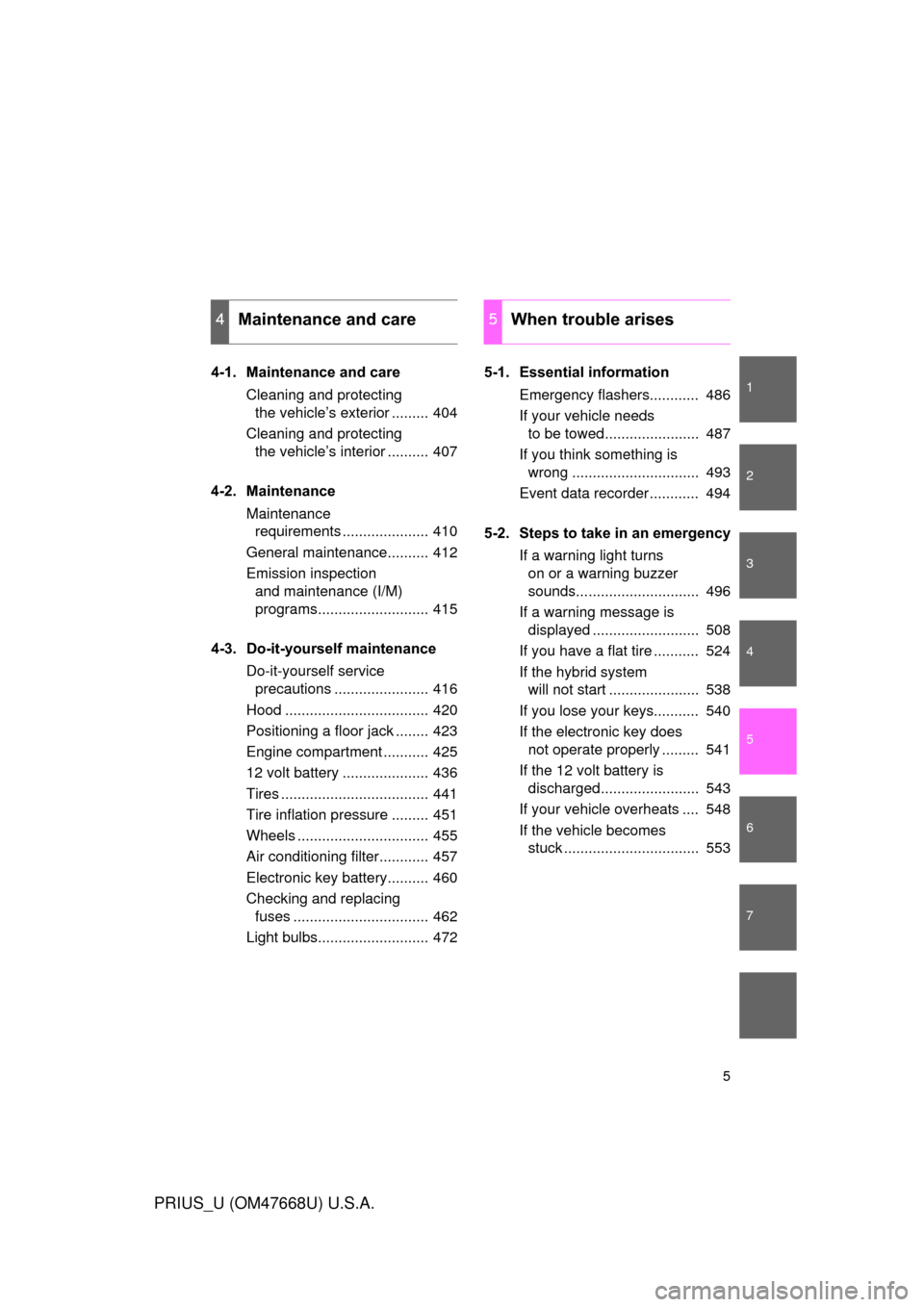
1
2
3
4
5
6
7
5
PRIUS_U (OM47668U) U.S.A.
4-1. Maintenance and careCleaning and protecting
the vehicle’s exterior ......... 404
Cleaning and protecting
the vehicle’s interior .......... 407
4-2. Maintenance Maintenance
requirements ..................... 410
General maintenance.......... 412
Emission inspection
and maintenance (I/M)
programs........................... 415
4-3. Do-it-yourself maintenance Do-it-yourself service
precautions ....................... 416
Hood ................................... 420
Positioning a floor jack ........ 423
Engine compartment ........... 425
12 volt battery ..................... 436
Tires .................................... 441
Tire inflation pressure ......... 451
Wheels ................................ 455
Air conditioning filter............ 457
Electronic key battery.......... 460
Checking and replacing
fuses ................................. 462
Light bulbs........................... 472 5-1. Essential information
Emergency flashers............ 486
If your vehicle needs
to be towed....................... 487
If you think something is wrong ............................... 493
Event data recorder ............ 494
5-2. Steps to take in an emergency If a warning light turns
on or a warning buzzer
sounds.............................. 496
If a warning message is
displayed .......................... 508
If you have a flat tire ........... 524
If the hybrid system
will not start ...................... 538
If you lose your keys........... 540
If the electronic key does
not operate properly ......... 541
If the 12 volt battery is
discharged........................ 543
If your vehicle overheats .... 548
If the vehicle becomes
stuck ................................. 553
4Maintenance and care5When trouble arises
Page 28 of 616
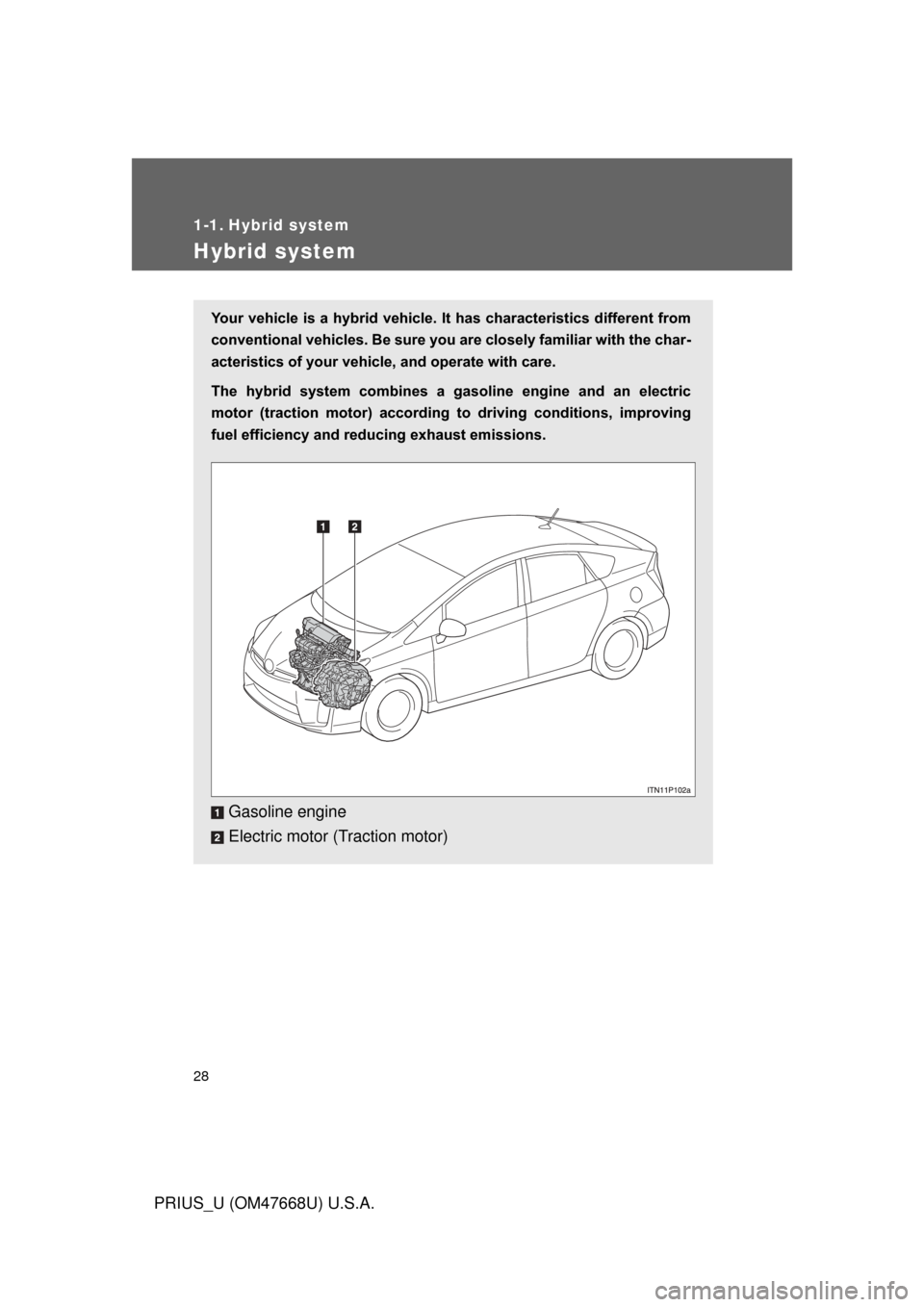
28
PRIUS_U (OM47668U) U.S.A.
1-1. Hybrid system
Hybrid system
Your vehicle is a hybrid vehicle. It has characteristics different from
conventional vehicles. Be sure you are closely familiar with the char-
acteristics of your vehicle, and operate with care.
The hybrid system combines a gasoline engine and an electric
motor (traction motor) according to driving conditions, improving
fuel efficiency and reducing exhaust emissions.
Gasoline engine
Electric motor (Traction motor)
Page 29 of 616
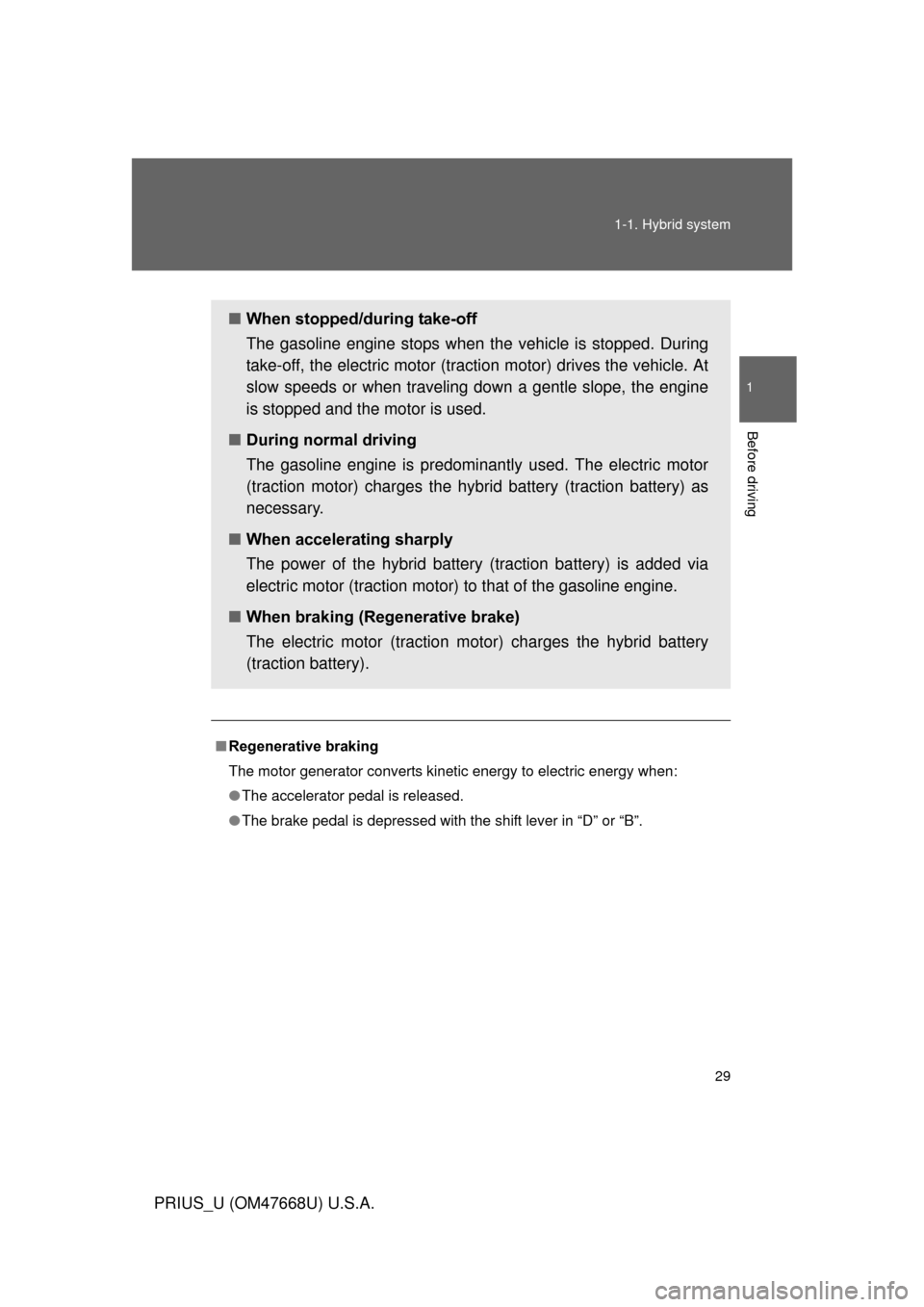
29
1-1. Hybrid system
1
Before driving
PRIUS_U (OM47668U) U.S.A.
■
Regenerative braking
The motor generator converts kinetic energy to electric energy when:
● The accelerator pedal is released.
● The brake pedal is depressed with the shift lever in “D” or “B”.
■ When stopped/during take-off
The gasoline engine stops when the vehicle is stopped. During
take-off, the electric motor (traction motor) drives the vehicle. At
slow speeds or when traveling down a gentle slope, the engine
is stopped and the motor is used.
■ During normal driving
The gasoline engine is predominantly used. The electric motor
(traction motor) charges the hybrid battery (traction battery) as
necessary.
■ When accelerating sharply
The power of the hybrid battery (traction battery) is added via
electric motor (traction motor) to that of the gasoline engine.
■ When braking (Regenerative brake)
The electric motor (traction motor) charges the hybrid battery
(traction battery).
Page 30 of 616
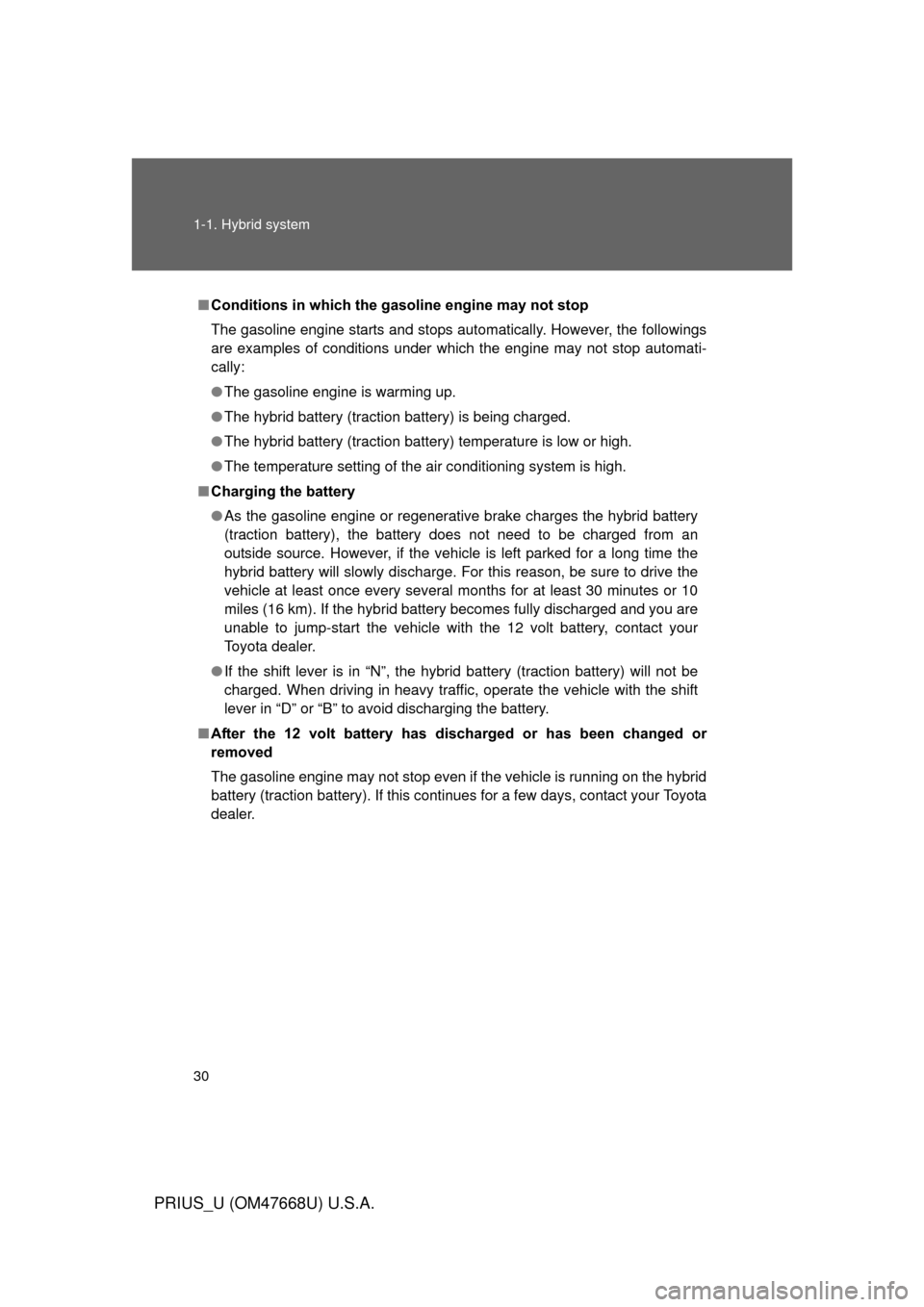
30 1-1. Hybrid system
PRIUS_U (OM47668U) U.S.A.
■Conditions in which the gasoline engine may not stop
The gasoline engine starts and stops automatically. However, the followings
are examples of conditions under which the engine may not stop automati-
cally:
● The gasoline engine is warming up.
● The hybrid battery (traction battery) is being charged.
● The hybrid battery (traction battery) temperature is low or high.
● The temperature setting of the air conditioning system is high.
■ Charging the battery
● As the gasoline engine or regenerative brake charges the hybrid battery
(traction battery), the battery does not need to be charged from an
outside source. However, if the vehicle is left parked for a long time the
hybrid battery will slowly discharge. For this reason, be sure to drive \
the
vehicle at least once every several months for at least 30 minutes or 10
miles (16 km). If the hybrid battery becomes fully discharged and you are
unable to jump-start the vehicle with the 12 volt battery, contact your
Toyota dealer.
● If the shift lever is in “N”, the hybrid battery (traction battery) will not be
charged. When driving in heavy traffic, operate the vehicle with the shift
lever in “D” or “B” to avoid discharging the battery.
■ After the 12 volt battery has disch arged or has been changed or
removed
The gasoline engine may not stop even if the vehicle is running on the hybrid
battery (traction battery). If this continues for a few days, contact your Toyota
dealer.
Page 31 of 616
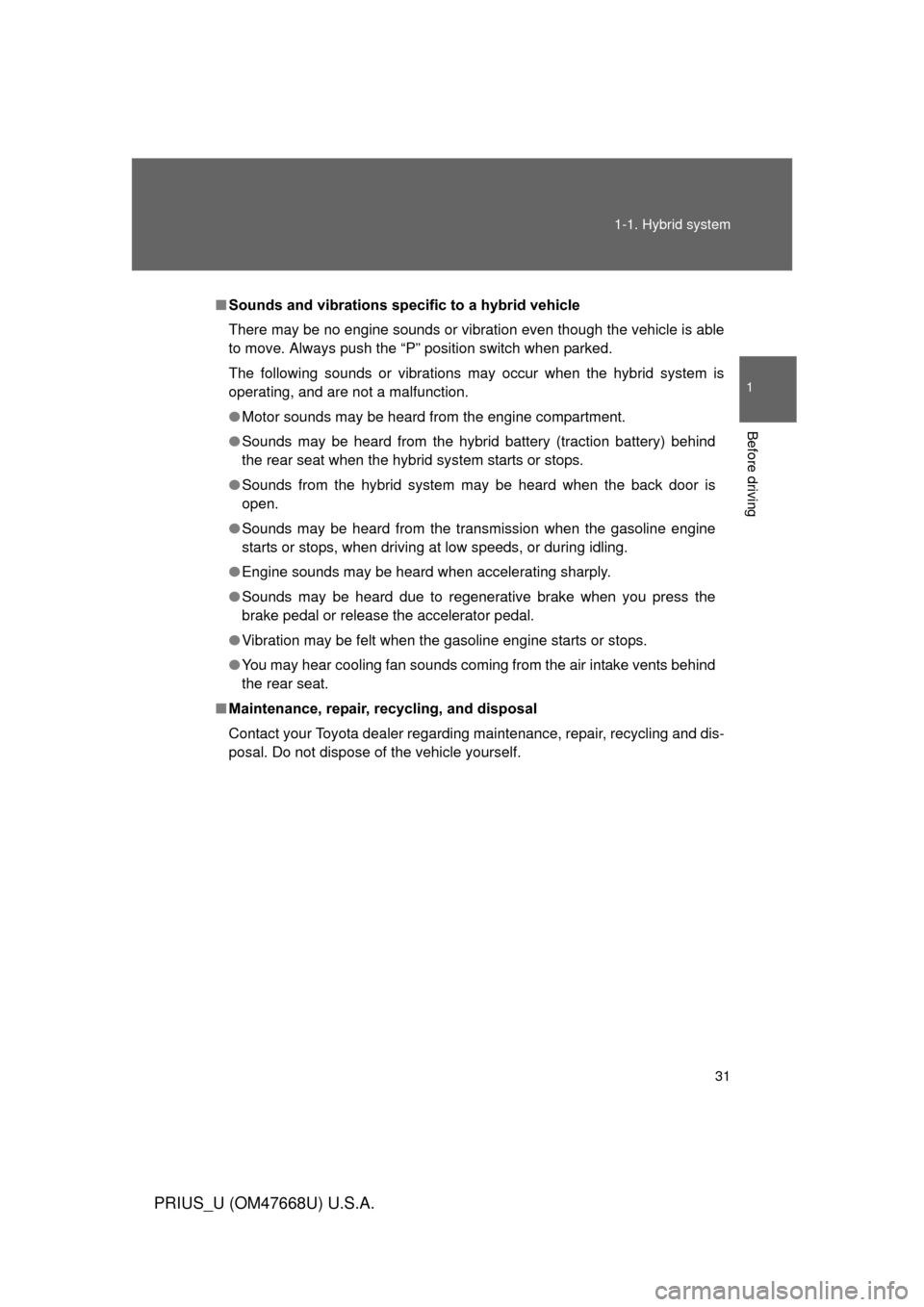
31
1-1. Hybrid system
1
Before driving
PRIUS_U (OM47668U) U.S.A.
■
Sounds and vibrations specific to a hybrid vehicle
There may be no engine sounds or vibration even though the vehicle is able
to move. Always push the “P” position switch when parked.
The following sounds or vibrations may occur when the hybrid system is
operating, and are not a malfunction.
● Motor sounds may be heard from the engine compartment.
● Sounds may be heard from the hybrid battery (traction battery) behind
the rear seat when the hybrid system starts or stops.
● Sounds from the hybrid system may be heard when the back door is
open.
● Sounds may be heard from the transmission when the gasoline engine
starts or stops, when driving at low speeds, or during idling.
● Engine sounds may be heard when accelerating sharply.
● Sounds may be heard due to regenerative brake when you press the
brake pedal or release the accelerator pedal.
● Vibration may be felt when the gasoline engine starts or stops.
● You may hear cooling fan sounds coming from the air intake vents behind
the rear seat.
■ Maintenance, repair, recycling, and disposal
Contact your Toyota dealer regarding maintenance, repair, recycling and dis-
posal. Do not dispose of the vehicle yourself.
Page 34 of 616

34 1-1. Hybrid system
PRIUS_U (OM47668U) U.S.A.
Eco Drive MonitorThe multi-information display features several screens to assist with
environmentally friendly driving. Y ou can drive in an environmentally
friendly manner by using these screens effectively.
■ Hybrid system operating condition
The energy monitor displays the
operating condition of the hybrid
system, showing such informa-
tion as the gasoline engine oper-
ating status, and the usage and
regeneration status of electrical
energy. (P. 190)
■ Driving efficiently
The Hybrid System Indicator changes in real-time in accordance with
the driving conditions and operation of the accelerator pedal. Driving
that is friendlier to the environmen t can be achieved by referring to
the display and by driving as follows. ( P. 192)
● When accelerating
Accelerate to the desired speed
while depressing the accelerator
pedal slowly and ensuring that
the indicator bar does not
exceed the Eco area.
Eco area
Page 152 of 616
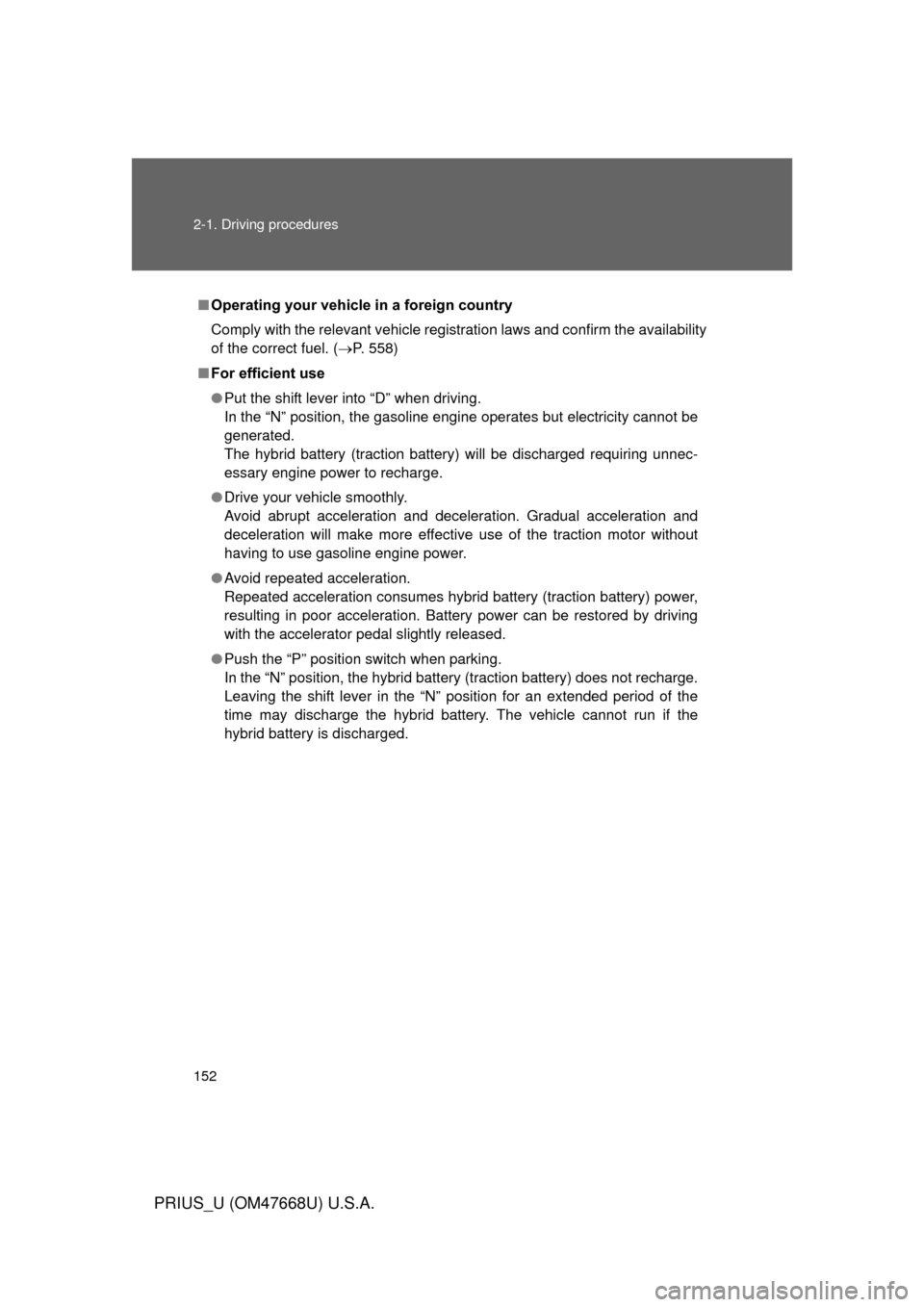
152 2-1. Driving procedures
PRIUS_U (OM47668U) U.S.A.
■Operating your vehicle in a foreign country
Comply with the relevant vehicle registration laws and confirm the availability
of the correct fuel. ( P. 558)
■ For efficient use
● Put the shift lever into “D” when driving.
In the “N” position, the gasoline engine operates but electricity cannot be
generated.
The hybrid battery (traction battery) will be discharged requiring unnec-
essary engine power to recharge.
● Drive your vehicle smoothly.
Avoid abrupt acceleration and deceleration. Gradual acceleration and
deceleration will make more effective use of the traction motor without
having to use gasoline engine power.
● Avoid repeated acceleration.
Repeated acceleration consumes hybrid battery (traction battery) power,
resulting in poor acceleration. Battery power can be restored by driving
with the accelerator pedal slightly released.
● Push the “P” position switch when parking.
In the “N” position, the hybrid battery (traction battery) does not recharge.
Leaving the shift lever in the “N” position for an extended period of the
time may discharge the hybrid battery. The vehicle cannot run if the
hybrid battery is discharged.
Page 153 of 616
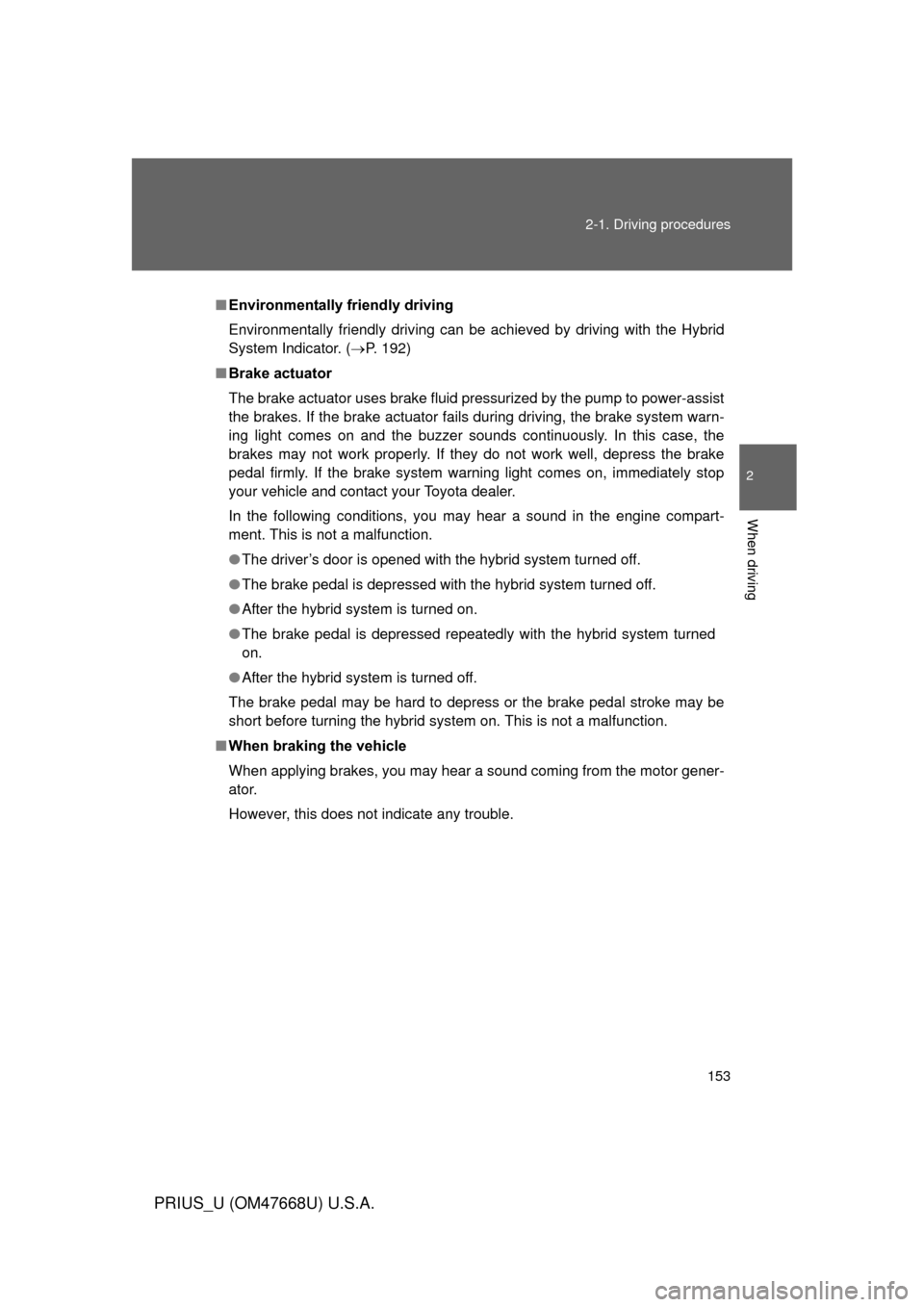
153
2-1. Driving procedures
2
When driving
PRIUS_U (OM47668U) U.S.A.
■
Environmentally friendly driving
Environmentally friendly driving can be ac hieved by driving with the Hybrid
System Indicator. ( P. 192)
■ Brake actuator
The brake actuator uses brake fluid pressurized by the pump to power-assist
the brakes. If the brake actuator fails during driving, the brake system warn-
ing light comes on and the buzzer sounds continuously. In this case, the
brakes may not work properly. If they do not work well, depress the brake
pedal firmly. If the brake system warning light comes on, immediately stop
your vehicle and contact your Toyota dealer.
In the following conditions, you may hear a sound in the engine compart-
ment. This is not a malfunction.
● The driver’s door is opened with the hybrid system turned off.
● The brake pedal is depressed with the hybrid system turned off.
● After the hybrid system is turned on.
● The brake pedal is depressed repeatedly with the hybrid system turned
on.
● After the hybrid system is turned off.
The brake pedal may be hard to depress or the brake pedal stroke may be
short before turning the hybrid system on. This is not a malfunction.
■ When braking the vehicle
When applying brakes, you may hear a sound coming from the motor gener-
ator.
However, this does not indicate any trouble.
Page 155 of 616
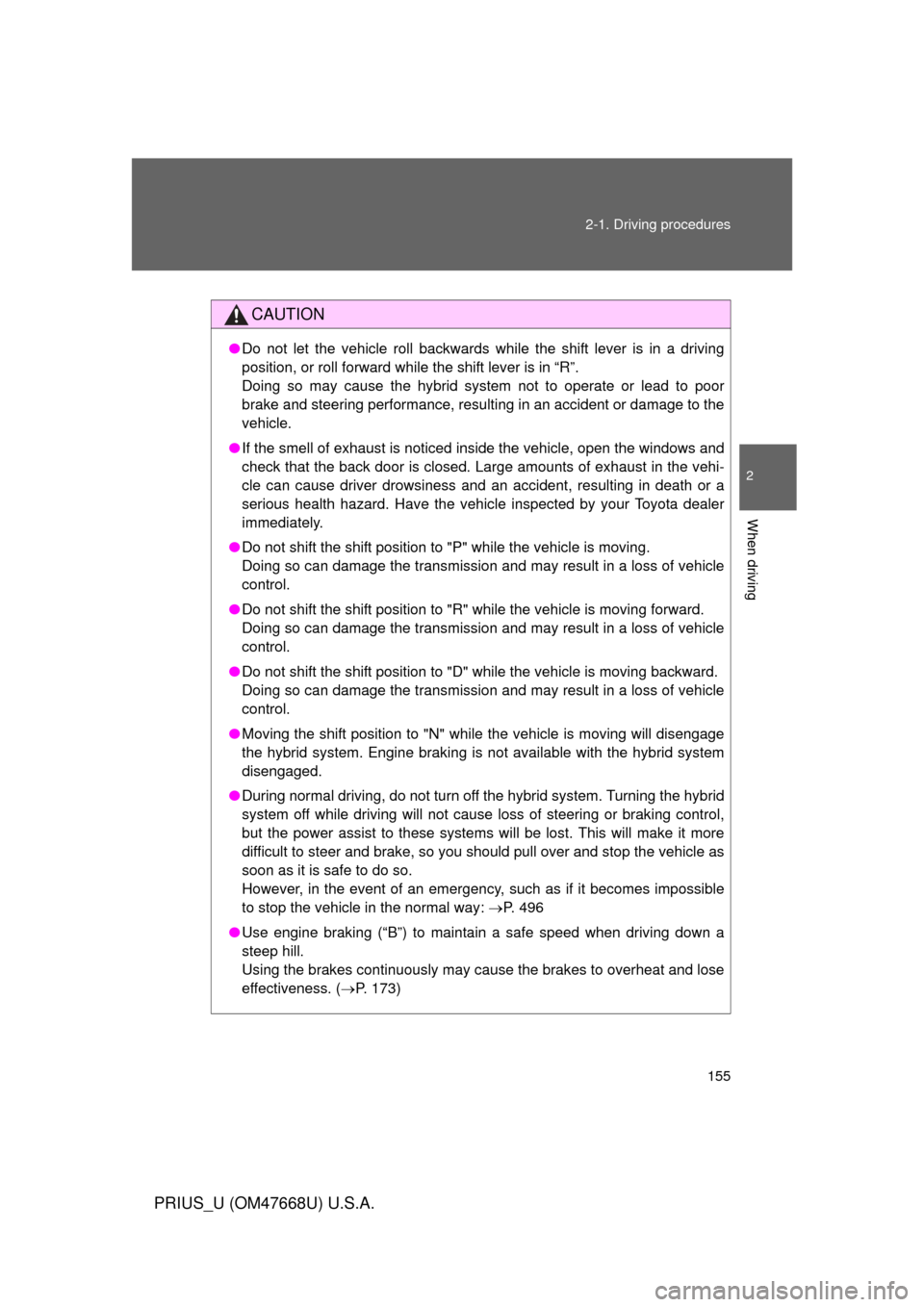
155
2-1. Driving procedures
2
When driving
PRIUS_U (OM47668U) U.S.A.
CAUTION
●
Do not let the vehicle roll backwards while the shift lever is in a driving
position, or roll forward while the shift lever is in “R”.
Doing so may cause the hybrid system not to operate or lead to poor
brake and steering performance, resulting in an accident or damage to th\
e
vehicle.
● If the smell of exhaust is noticed inside the vehicle, open the windows and
check that the back door is closed. Large amounts of exhaust in the vehi-
cle can cause driver drowsiness and an accident, resulting in death or a
serious health hazard. Have the vehicle inspected by your Toyota dealer
immediately.
● Do not shift the shift position to "P" while the vehicle is moving.
Doing so can damage the transmission and may result in a loss of vehicle\
control.
● Do not shift the shift position to "R" while the vehicle is moving forward.
Doing so can damage the transmission and may result in a loss of vehicle\
control.
● Do not shift the shift position to "D" while the vehicle is moving backward.
Doing so can damage the transmission and may result in a loss of vehicle\
control.
● Moving the shift position to "N" while the vehicle is moving will disengage
the hybrid system. Engine braking is not available with the hybrid system
disengaged.
● During normal driving, do not turn off the hybrid system. Turning the hybrid
system off while driving will not cause loss of steering or braking control,
but the power assist to these systems will be lost. This will make it more
difficult to steer and brake, so you should pull over and stop the vehicle as
soon as it is safe to do so.
However, in the event of an emergency, such as if it becomes impossible
to stop the vehicle in the normal way: P. 496
● Use engine braking (“B”) to maintain a safe speed when driving down a
steep hill.
Using the brakes continuously may cause the brakes to overheat and lose
effectiveness. ( P. 173)
Page 156 of 616
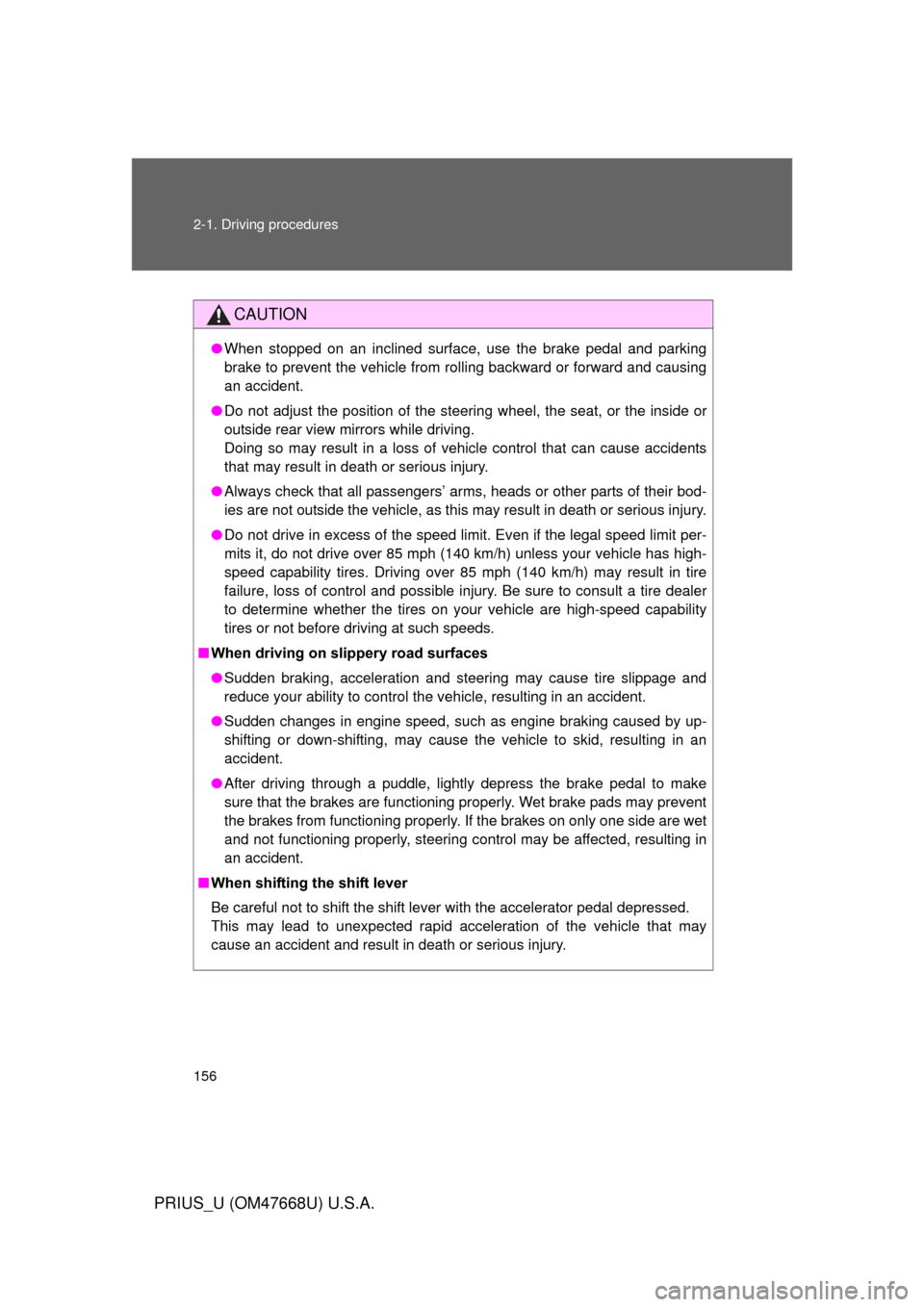
156 2-1. Driving procedures
PRIUS_U (OM47668U) U.S.A.
CAUTION
●When stopped on an inclined surface, use the brake pedal and parking
brake to prevent the vehicle from rolling backward or forward and causing
an accident.
● Do not adjust the position of the steering wheel, the seat, or the inside or
outside rear view mirrors while driving.
Doing so may result in a loss of vehicle control that can cause accidents
that may result in death or serious injury.
● Always check that all passengers’ arms, heads or other parts of their bod-
ies are not outside the vehicle, as this may result in death or serious injury.
● Do not drive in excess of the speed limit. Even if the legal speed limit per-
mits it, do not drive over 85 mph (140 km/h) unless your vehicle has high-
speed capability tires. Driving over 85 mph (140 km/h) may result in tire
failure, loss of control and possible injury. Be sure to consult a tire dealer
to determine whether the tires on your vehicle are high-speed capability
tires or not before driving at such speeds.
■ When driving on slippery road surfaces
● Sudden braking, acceleration and steering may cause tire slippage and
reduce your ability to control the vehicle, resulting in an accident.
● Sudden changes in engine speed, such as engine braking caused by up-
shifting or down-shifting, may cause the vehicle to skid, resulting in an
accident.
● After driving through a puddle, lightly depress the brake pedal to make
sure that the brakes are functioning properly. Wet brake pads may prevent
the brakes from functioning properly. If the brakes on only one side are wet
and not functioning properly, steering control may be affected, resulting in
an accident.
■ When shifting the shift lever
Be careful not to shift the shift lever with the accelerator pedal depressed.
This may lead to unexpected rapid acceleration of the vehicle that may
cause an accident and result in death or serious injury.